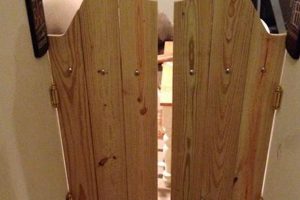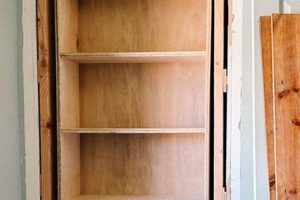A cavity sliding door, frequently implemented as a space-saving solution, recedes into a compartment within the adjacent wall when open. This design eliminates the swing radius of a traditional hinged door. The installation process, when undertaken by the homeowner, represents a cost-effective approach to interior remodeling. An example includes replacing an existing swinging door with one that slides into the wall to enlarge a bathroom’s usable space.
This type of door offers significant advantages in areas where maximizing floor space is critical. Historically, it was utilized in areas with limited square footage or to create an unobtrusive doorway. The adoption of this system can improve room flow and accessibility, potentially increasing the property’s overall value by optimizing the use of available area.
The subsequent sections will detail the preparation, installation, and finishing aspects of integrating this space-saving feature into a residential setting. Focus will be placed on ensuring structural integrity, smooth operation, and aesthetic integration with the existing decor. The article will further address common challenges and troubleshooting techniques to ensure a successful outcome.
Installation Best Practices
The following guidelines are intended to improve the outcome when installing a cavity sliding door unit. Adherence to these practices can minimize complications and ensure a structurally sound and aesthetically pleasing result.
Tip 1: Accurate Measurements: Precise measurements of the door opening are crucial. Ensure the rough opening dimensions adhere strictly to the manufacturer’s specifications to prevent binding or misalignment of the door.
Tip 2: Structural Integrity of the Pocket Frame: The pocket frame must be square and plumb before drywall installation. Verify this with a level and a square. Any deviation can lead to operational problems post-installation. Reinforce the frame if necessary.
Tip 3: Header Support: Adequate header support above the pocket opening is vital. The header must be capable of bearing the load without deflection, which can impact the door’s sliding mechanism. Consult a structural engineer if unsure of load requirements.
Tip 4: Track Leveling: The track upon which the door glides must be perfectly level. Use a spirit level to confirm levelness. An unlevel track will cause the door to drift open or closed and experience premature wear.
Tip 5: Roller Adjustment: The rollers must be properly adjusted to ensure smooth and quiet operation. Fine-tune the roller height according to the manufacturer’s instructions. Over-tightening or loosening can impede performance.
Tip 6: Drywall Installation: When installing drywall around the pocket frame, avoid excessive screw penetration into the frame itself. This can obstruct the door’s movement. Use shims to maintain a consistent gap.
Tip 7: Hardware Selection: Opt for high-quality hardware specifically designed for this door application. Inferior hardware can lead to premature failure and operational difficulties. The hardware should be rated for the door’s weight and frequency of use.
Adhering to these best practices during the installation process will result in a smoothly operating, long-lasting, and aesthetically integrated feature within the home. Consistent application of these guidelines mitigates the risk of operational failure and ensures alignment with design expectations.
The subsequent conclusion will recap the vital elements of the process. It will further offer insights into long-term maintenance procedures.
1. Planning
The initial phase in the successful integration of a cavity sliding door involves meticulous planning. This preliminary assessment directly influences the structural integrity, operational efficacy, and overall aesthetic harmony of the final installation. Inadequate planning can precipitate complications such as incorrect sizing, structural deficiencies, or incompatibility with existing architectural elements. An example of insufficient planning manifests when an existing wall contains essential plumbing or electrical conduits, rendering the intended pocket location unsuitable without costly and complex rerouting.
Comprehensive planning encompasses evaluating the structural soundness of the intended wall, verifying its ability to accommodate the pocket frame without compromising load-bearing capacity. It includes precisely measuring the rough opening dimensions to ensure compatibility with the selected door size and hardware. Furthermore, the planning phase necessitates a detailed assessment of potential obstructions within the wall cavity, such as wiring, plumbing, or HVAC ductwork. Neglecting these considerations may result in project delays, increased costs, and compromised structural integrity. An instance may be choosing a place where a bigger, wider door is necessary, only to discover that the wall cannot fully retract the door, causing misalignment, and an improper fit. A proper plan also factors in the swing of any adjacent doors to avoid interference.
In summary, thorough planning is not merely a preparatory step but an indispensable prerequisite for the successful implementation of a cavity sliding door. Diligent planning minimizes the risk of unforeseen challenges, optimizes resource allocation, and ensures the seamless integration of the door within the existing architectural framework. This focus streamlines the installation process and contributes to a functional, durable, and aesthetically pleasing outcome. In the absence of such preparation, projects are more likely to fail because of the various potential problems that go unmitigated.
2. Framing
Framing represents a foundational element in the successful installation of a cavity sliding door. It provides the structural support and defines the opening within which the door operates. Precise and accurate framing is critical for smooth operation and long-term durability.
- Structural Integrity of the Pocket:
The framing creates the “pocket” into which the door slides. This structure must be robust enough to withstand the forces exerted by the door’s weight and operation. Insufficient framing can lead to bowing or warping, resulting in binding and operational failure. Example: Using undersized lumber for the pocket frame can cause it to deflect under the weight of the door, hindering smooth gliding.
- Accurate Opening Dimensions:
The framed opening must adhere precisely to the door manufacturer’s specified dimensions. Deviation from these dimensions can cause the door to bind, rub against the frame, or fail to close properly. Example: If the framed opening is too narrow, the door will not slide fully into the pocket. If it is too wide, it may rattle or allow excessive light and sound transmission.
- Plumb and Level Alignment:
The framing must be perfectly plumb and level. Any deviation from these alignments will translate into operational problems, such as the door drifting open or closed. Example: An out-of-plumb frame will cause the door to experience uneven pressure on the rollers, resulting in jerky movement or premature wear.
- Header Support and Load Distribution:
The header above the pocket opening must be adequately supported to carry the load of the wall and any superimposed structures. Insufficient header support can lead to sagging, affecting the operation of the door and potentially compromising the structural integrity of the wall. Example: Removing a load-bearing wall section without properly supporting the header above the pocket frame can cause the wall to settle, leading to door misalignment and operational problems.
In conclusion, the framing for a cavity sliding door is more than simply creating an opening. It is a critical structural component that directly influences the functionality and longevity of the door system. Precise measurements, robust construction, and accurate alignment are essential for a successful installation and trouble-free operation.
3. Hardware
The functionality and longevity of a cavity sliding door are intrinsically linked to the quality and appropriateness of its associated hardware. The hardware components, including the track, rollers, door guides, and locking mechanisms, directly influence the door’s ease of operation, stability, and security. For example, utilizing substandard rollers may lead to premature wear, resulting in a noisy and uneven gliding motion. Conversely, high-quality, precision-engineered rollers contribute to a smooth, quiet, and effortless user experience. Selection of appropriate hardware is not merely an aesthetic consideration; it is a fundamental factor that determines the operational effectiveness of the door.
The selection of pocket door hardware should also consider the door’s weight and dimensions. Heavier or wider doors necessitate robust tracks and rollers capable of bearing the increased load without deformation or failure. The door guides play a crucial role in maintaining the door’s alignment within the pocket, preventing rubbing against the frame and ensuring a consistent reveal. Inadequate door guides can result in the door becoming misaligned, leading to operational difficulties and potential damage to the door and frame. Furthermore, if privacy or security is a concern, the chosen locking mechanism must be specifically designed for pocket doors and provide a secure and reliable closure.
In summary, the hardware components represent a critical investment in the overall performance and durability of a cavity sliding door. Selecting high-quality, load-appropriate, and precisely engineered hardware is essential for achieving smooth, quiet, and reliable operation. Neglecting hardware considerations can lead to premature wear, operational difficulties, and compromised security, ultimately undermining the benefits of this space-saving door system. Therefore, careful attention must be paid to matching the hardware specifications to the door’s characteristics and the intended application.
4. Installation
The installation process is paramount to the successful implementation of a DIY pocket door project. It represents the practical application of prior planning and material acquisition. Improper installation can negate the benefits of even the highest quality door and hardware. The outcome of the installation phase directly impacts the door’s operational smoothness, structural integrity, and long-term reliability. An example of this cause-and-effect relationship is misaligned rollers, resulting from careless installation, leading to friction and difficulty in sliding the door. This friction, if left unaddressed, can escalate, causing damage to the track and the door itself.
The installation procedure encompasses several critical stages. These include preparing the wall cavity, assembling and inserting the pocket frame, hanging the door, and adjusting the hardware for optimal performance. Each stage requires precision and adherence to the manufacturer’s instructions. For example, during the pocket frame insertion, ensuring the frame is perfectly square and plumb is crucial. Failure to achieve this alignment will inevitably lead to the door binding or rubbing against the frame. Furthermore, correct door hanging involves precise measurements and the use of shims to achieve a level and even reveal.
In conclusion, the installation phase is not merely a mechanical process but a pivotal determinant of the overall success of a DIY pocket door. The meticulous execution of each step, coupled with a thorough understanding of the underlying principles, is indispensable for ensuring a functional, durable, and aesthetically pleasing final product. Challenges encountered during this phase underscore the importance of patience, attention to detail, and a proactive approach to problem-solving. Proper installtion, ultimately transforms separate elements into a functional and seamlessly integrated space saving solution.
5. Finishing
The finishing stage of a cavity sliding door installation directly impacts the visual integration of the door with its surrounding environment. This phase encompasses tasks such as applying paint, stain, or other decorative treatments to the door and trim, ensuring a cohesive aesthetic. The quality of the finishing directly influences the perceived value and professional appearance of the installation. For instance, uneven paint application or mismatched trim colors can detract from an otherwise well-executed project, creating a visual dissonance that undermines the overall aesthetic.
The finishing process also serves a protective function. Applying a sealant or topcoat to the door and trim can safeguard against moisture damage, scratches, and other forms of wear. This is particularly important in high-traffic areas or rooms prone to humidity, such as bathrooms and kitchens. A properly applied finish extends the lifespan of the door and reduces the need for frequent maintenance or replacement. An example is applying a polyurethane finish to a wooden door, offering enhanced resistance to water and abrasion compared to an unfinished surface.
In conclusion, the finishing stage of this space saving door represents more than a cosmetic enhancement; it is an integral component that influences the door’s visual appeal, durability, and long-term performance. Attention to detail during the finishing process ensures a professional-looking result that seamlessly integrates with the existing decor, enhancing the overall value and aesthetic quality of the installation. Failing to address the finishing process adequately will yield a substandard product and detract from the broader investment in the space saving project.
Frequently Asked Questions Regarding DIY Pocket Door Installations
The following represents a compilation of frequently asked questions concerning the implementation of a cavity sliding door system. These questions address common concerns and misconceptions.
Question 1: What is the appropriate method for determining the correct size of a pocket door relative to the existing wall opening?
Accurate measurement of the finished wall opening is paramount. Consult the door manufacturer’s specifications for recommended rough opening dimensions. Ensure sufficient space exists within the wall cavity to accommodate the door’s full width when recessed.
Question 2: What structural considerations are necessary when installing a pocket door in a load-bearing wall?
Installing in a load-bearing wall necessitates careful assessment of the header’s load-bearing capacity. A structural engineer should be consulted to determine if reinforcement is required to maintain the wall’s structural integrity. Failure to provide adequate support can compromise the building’s stability.
Question 3: Which materials are recommended for constructing the pocket frame to ensure durability and prevent warping?
Kiln-dried lumber is recommended to minimize warping. Select straight, knot-free lumber to ensure the frame remains square and plumb over time. Metal framing options are also available and offer superior resistance to moisture and warping.
Question 4: How can smooth and quiet operation of the pocket door be achieved?
Employ high-quality rollers and a precisely aligned track system. Ensure the door is properly hung and that the rollers are correctly adjusted. Lubricate the track and rollers periodically to reduce friction and noise.
Question 5: What methods are effective for preventing the pocket door from jumping off the track?
Utilize door guides at the bottom of the door to maintain alignment within the pocket. Ensure the track is securely mounted and that the rollers are properly engaged. Inspect the rollers and track regularly for wear and tear.
Question 6: What steps can be taken to minimize sound transmission through a pocket door?
Install sound-dampening materials within the wall cavity. Use weather stripping around the door perimeter to create a tight seal. Consider a solid-core door for improved sound insulation.
Careful consideration of these factors can significantly improve the outcome of a DIY cavity sliding door installation. Adherence to these guidelines promotes functionality and durability.
The subsequent section will offer a conclusion to encapsulate the core tenets of implementing a functional and long-lasting cavity sliding door.
Conclusion
The preceding exploration of “diy pocket door” projects has highlighted several critical junctures. Successful implementation hinges upon meticulous planning, accurate framing, appropriate hardware selection, precise installation, and careful finishing. Neglecting any of these phases may compromise the door’s functionality, longevity, and aesthetic integration within the intended space.
Mastery of these elements ensures the project results in a functional, durable, and visually appropriate space-saving solution. Future projects will be improved by focusing on these elements. Further exploration of advanced hardware options, and innovative space utilization strategies may result in additional enhancements to this valuable home improvement endeavor.







